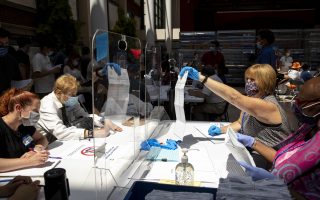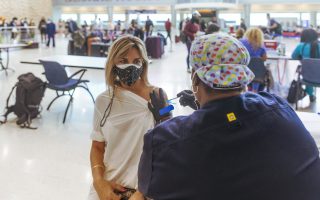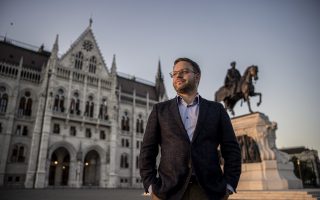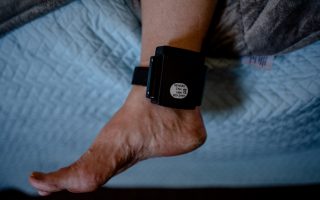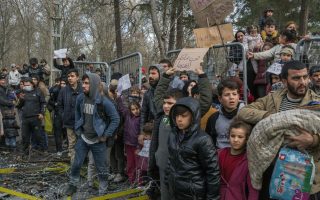A Covid epicenter hustles back to life: ‘What you see, it’s survival’

NEW YORK – Every day along Roosevelt Avenue in Queens, people stream off the elevated subway into a swarm of activity. Vendors ring bells and shout in Spanish – “Masks! Water! Shaved ice!” – as smoke rises from grilling meat and cumbia music competes with the rumble of the train.
A vibrant energy seems to have returned to the cluster of neighborhoods in north central Queens that became the first epicenter of the coronavirus in the country. A year ago, thousands had fallen ill, and hundreds had died.
But beneath the bustle lies desperation. The vendors, whose broad array of street food reflects the area’s diversity, often have lost steady jobs and do not know how else to make money. Residents and many business owners have fallen far behind on rent, protected only by a state moratorium on evictions that is set to expire at the end of the summer. Food pantry lines remain long.
“The beauty of what we see is that the immigrant community always finds a way to get by,” said Francisco Moya, a local Democratic city councilman. But it should not be confused with recovery, he added. “What you see on Roosevelt Avenue – it’s survival.”
Jenny Escobar, who once had a reliable job as a babysitter, now spends her days sitting on 82nd Street beside a cooler filled with homemade ice pops that she sells for $2 apiece. “There’s no work,” Escobar said. “There’s nothing.”
Escobar, who is from Colombia and like many of those interviewed spoke in her native Spanish, said whatever she earns goes toward paying back rent, and she feared what might happen to her and her fellow vendors if they lose this lifeline. City agencies have started to increase enforcement again this summer, putting unlicensed vendors at risk of steep fines.
At Make the Road New York, a community organization, about 600 people still collect food each week at their Jackson Heights location, organizers said, more than double the number of people served before the pandemic.
The interlocking neighborhoods – Corona, Jackson Heights, Elmhurst, East Elmhurst and Woodside – are home to a high concentration of people in the US illegally who have been ineligible for government aid such as stimulus checks and unemployment insurance.
Many qualify for some newly created benefits, such as a state rent relief program and the Excluded Workers Fund – a $2.1 billion fund to give one-time cash payments to people without legal status who lost work. But the money from that fund is not yet available; state officials are still ironing out the distribution process.
There are some promising signs of recovery. In Corona, one of the ZIP codes hit hardest by the pandemic in New York, hospitalizations have declined to fewer than a dozen, and vaccination rates, which have lagged behind other spots in the city, are creeping up.
And while scattered businesses closed – including medical, dental and legal offices – most shops and restaurants have stayed open, according to the Queens Chamber of Commerce and others in the local business community. Some ZIP codes in the area are even among the handful in the city that added more new businesses last year than in the year before the pandemic.
But for most, recovery still feels far away.
“A lot of friends have called to ask, ‘Is there a corner where I can sleep?’” said Patricio Santiago, a carwash worker originally from Mexico, who made about $200 a week throughout the pandemic, and whose family of four shares a one-bedroom apartment in Jackson Heights with another family.
There long has been an underground housing market in the area: People sublease rooms in apartments to help cover their own rent. The practice created overcrowding that fueled the spread of the virus and meant that many people – largely, men working to support families in Latin America – were kicked out of rented rooms when they lost their jobs and income. Homeless encampments have grown. After the eviction moratorium ends on Aug. 31, the situation could worsen.
Leslie Ramos, the executive director of the 82nd Street Partnership, the local Business Improvement District, said many business owners are also far behind on rent and surviving because the moratorium on evictions also covered their leases.
“If you walk here, you would not know that the businesses are struggling. Our streets are busy, very busy. But we know the reality is quite different,” Ramos said.
Sonia Izurraga’s salon, Peruvian Connection, is up and running in its tiny storefront in Jackson Heights. But Izurraga said she fell far behind on the rent while closed and could not access the federal paycheck protection program, and other aid for small businesses, because of her immigration status. She is hoping to pay her landlord the three months’ rent she still owes. “Like I told the man,” she said, “Without loans, all I can do is try.”
One hairdresser had brought in her son because she was unable to pay for childcare while his elementary school was closed. Between classes on his tablet, he swept hair from the floor.
The tight-knit fabric of the neighborhood has helped some businesses hang on. When Glen Mirchandani reopened his jewelry store on 82nd Street, Devisons Jewelers, last year, he offered nurses from Elmhurst Hospital discounts and free repairs. That helped, he said, as did people’s personal stimulus checks. They wanted to support his three-decade old business, he said, and to treat themselves. His longtime landlord gave him time. “He says, ‘Pay little by little,’” said Mirchandani, whose small store was full of customers on a recent afternoon.
Restaurants that served free meals during the pandemic, such as Mojitos, in Jackson Heights, have similarly seen grateful customers return.
But business in many places remains slow.
In Little Bangladesh, in Jackson Heights, halal butchers, grocers and dress shops selling silk saris have long relied on people driving in from outside the area to stock up on items. Those customers have still not come back in large numbers, said a clerk at Khaamar Baari, a food market on 73rd Street, who said he was not authorized by his employer to give his name.
Much of what could once be counted on is gone. Milton Montesdeoca, who drives a moving van, sat near a row of such vans parked in Corona on a recent afternoon. Once, he could rely on two or three moves a week. Now, he said, virtually no one is changing homes because of the eviction moratorium. Here, as elsewhere, there are ghosts. Two fellow moving men had died from the coronavirus, Montesdeoca said. Several had lost relatives. Everyone, he said, knows someone who died.
Shops and restaurants have also faced competition from the proliferating street vendors. Sales have fallen off dramatically this year at Gato Verde, Maria Pullo’s small juice joint on Roosevelt Avenue, which she blamed on all the vendors selling jugos naturales, or fresh juice. “Nothing, kid,” she said, of her earnings. “We pay electricity, gas, rent,” she added.
“Sometimes I feel like closing up and leaving,” Pullo said.
Many here still wear masks, though the mandate has been lifted, but there are few other signs of the impact the coronavirus had on this part of Queens: a scattering of black ribbons, some laminated photos of the lost. The struggle to get by has thrust grief into the background. But beneath the music and the chatter, it is everywhere.
As he chopped at coconuts with a machete at his stand on 82nd Street, Aureliano Mendoza described losing a job he had held for more than a decade – distributing Mexican goods for a New Jersey store – and getting by on what came down, at one point, to $60 a month. He and his wife battled the coronavirus for weeks, but avoided the hospital, though he nearly died. Then a sister in Mexico succumbed to Covid-19, said Mendoza, as his eyes filled with tears.
Moya, the councilman, said the pandemic had exposed long-standing issues with housing, health care and employment that left residents here particularly vulnerable to the virus and shutdown. And while people are struggling to get ahead, he said, those inequities remain. “We can’t pat ourselves on the shoulder and say, ‘Good, we are making a comeback,’” he said.
This article originally appeared in The New York Times.

